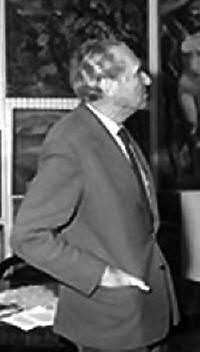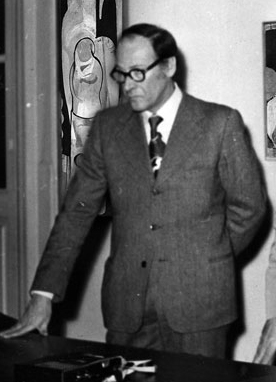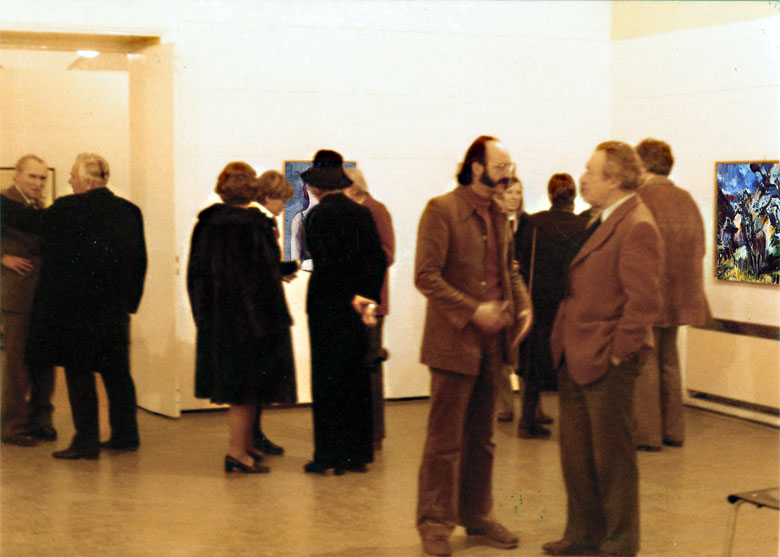|
INAUGURATION EXHIBITION KUNSTVEREIN MUNICH
Grossen Saal - February 3rd, 1977
- h. 20 |
|
|
OPENING ADDRESS BY HANS
ECKSTEIN ART HISTORIAN

The 20's for young artists in Munich were by no
means as rosy as was generally described in accounts
of the times. The city, although owning a rich
artistic tradition, was not particularly open
towards avant-garde ideas, to new forms of
expression whether in painting, sculpture or
architecture.The established, long-standing artistic
groups were not keen to grant exhibition space to
new young talent. Nor could the new wave expect much
help from municipal or state arts bodies. So a small
but enthusiastic band of young artists joined
together in the movement they named Juryfreie with a
founding charter based on mutual friendship and firm
opposition to the entrenched power of the artistic
establishment.
Without doubt they saw themselves as
revolutionaries; and they were. At the start of the
1930's anyone interested in meeting these new young
artists and getting to know their work could go to
the exhibition rooms the "Juryfreien" had set up on
the corner of Prinzregenstrasse opposite the Prinz
Carl Palace. Here visitors could see not only
paintings by Juryfreie members but also work by
artists which established galleries (both
state-owned and private) still refused to show.
Abstract and surrealist artists like Albers, Arp,
Baumeister, Brancusi, Max Ernst, Mondrian, Picasso
and Schwitters to name just a few were exhibited for
the first time in Munich thanks to the Juryfreie.
The group also featured work by modern architects
whose designs would otherwise have been ignored. The
movement also organised concerts of contemporary
music featuring the work of composers like Karl
Amadeus Hartmann and Milhaud among others. Sales of
paintings at the exhibitions did not even cover
expenses so the group organised carnival parties as
a way of raising funds. The Juryfreie parties soon
became famous in a city of inveterate partygoers.
But the fun soon came to an end with the arrival of
Hitler and his brown-shirted national socialists.
They would decide what was art and what wasn't. The
banning of the Juryfreie movement was part of a
broader cultural attack aimed at destroying
"Bolshevik" cultural organisations. Juryfreie
members could now only paint, sculpt and make
architectural designs in hiding. If I have described
the situation in which young artists in Munich found
themselves around 1930 and given an outline of the
Juryfreie's activities, it is because it was at this
time and in this situation that the painter
Christian Hess was living in the Bavarian capital.
I first saw his paintings at a Juryfreie
exhibition. It was at one of the group's parties
that I first met Hess. He was around 35 with sharp
features and a pleasant, intelligent expression. He
was not very tall, slim and seemed to possess a
typically Bavarian temperament - but the almost
impertinent openness clearly concealed a deep
sensitivity.
I remember at one exhibition on Prinzregenstrasse I
was looking at some paintings by Joseph Scharl
(similar to Van Gogh) but I was far more struck by
the quiet serene canvasses by Christian Hess which
had been hung alongside. Of all the paintings which
I viewed during that period in Munich those by Hess
are without doubt the ones of which I maintain the
clearest memory. So, when I recently visited Messina
and saw the meticulously curated retrospective of
Hess' paintings, I was able to make my acquaintance
once again with many of his works. There was in no
way the sense of disappointment that sometimes
occurs when after decades you meet an old friend -
or an old painting - on the contrary.
Many of the later paintings which I was seeing for
the first time served only to strengthen my previous
impressions. The promise shown by the artist in his
early thirties had been richly fulfilled in his
later works. I could not have known this in 1948
when at a vast exhibition in Munich I saw again two
of Hess' paintings which clearly stood out from the
majority of the works on show for their sheer
expressive power.
But by that time, when artists in Germany were once
again able to paint and exhibit their work, Hess was
already dead. He did not have an easy life; perhaps
he had not sought it. Although he did everything
well: painting, drawing, carving puppets, playfully
sculpting figures in the sands on the Baltic coast
and modelling with such hard work and diligence in
his studio. He was by no means without
self-criticism and he took his artistic activity far
more seriously than might have seemed to an
outsider.
He left the gymnasium early and enrolled in the
Innsbruck State arts and crafts institute where he
began painting. Later he had to work at the Mader
art glass studios in Innsbruck and at the Kuntner
ceramic workshop in Brunico before he was able to
begin studying at the Akademie der Bildenden Künste
in Munich in 1919. Even after he had completed his
studies under Becker Gundhal, Hess had to keep busy
in the search to make some money.
In a jeweller in Pforzheim he found not a patron but
a source of commissions for copies of old masters
displayed in museums in Vienna and Florence.
Although this activity hardly served to meet his
longing for artistic affirmation, it is possible to
maintain that it did help to develop and refine his
innate sense of colour, shade and tone. In any case,
copying did not lead Hess, as it did Lenbach, to
old-style mannerism. He learned from the old masters
but he reserved the right to find his own way of
expressing form and colour which he found in nature.
In the beginning much of Hess' painting is clearly
influenced by the Munich school. His unflagging
enthusiasm for drawing and painting from nature
allowed him to move beyond and find new freedoms.
Above all his long stays in Italy and the summer he
spent in Sicily at his sister's - who had married
and settled in Messina - helped him enormously in
the search for an artistic language in which he
could achieve greater self-expression.
In many paintings from 1927 and 1928 there is a
growing sense of colour and an increased precision
of form. The statue of Neptune at Messina, a highly
expressive work by a classicist sculptor, provided
the impulse for a majestic composition in which the
real is developed to almost mythical-allegorical
proportions and offers an element of magical
romanticism which in some respects may remind
viewers of De Chirico.
Sometimes one may observe a tendency to overcome
form to reach a more expressive perspective, as in
the painting “Ponte di Bracciano” and in the
superbly modelled "Reclining Torso". A group of
houses becomes an abstract composition of red and
black cubes. Emotions found in the paintings of
Cezanne are elaborated on in still lifes of
beautiful lyrical reality. In the landscapes the
graduation of colours and tones is majestic. Towards
1930 the nudes - in drawings and paintings - become
more animated and in the same period there are also
still lifes of clearly abstract construction.
For all those who decades ago saw only a few
individual paintings by Christian Hess this
exhibition which brings together his oil paintings
and drawings - unfortunately examples of his plastic
art have almost completely disappeared - offers a
first look at the development of this richly
talented artist. All the other artists are present
with one work, allowing us to place Christian Hess
clearly among the most interesting talents to have
come out of the rich traditions of the Munich school
in the period between the two wars and follow new
directions.
|
|
|
|
|
Address by Nuccio
Cinquegrani of the promoting committee |
|
|

Thirty years
after the last Exhibition of the works by Christian Hess at the
Exportschau, I’m honoured to present in Munich the evidence of this
painter’s life and artistic production, one of the most valued
representatives of the “Juryfreie”. On behalf of the here present niece
of Christian Hess, Mrs. Luisa Ardizzone, and of the promoting committee
from Sicily, the place where Hess found new inspiration and warm
hospitality, I address my greeting to the personalities who have
supported the initiative and the German artists who succeeded in
maintaining their freedom of thought. I also want to mention the
Director of the Italian Cultural Institute, Prof. Aldo Lucarini, a man
of uncommon spiritual gifts, recently disappeared, who supported the
first important Retrospective Exhibition of Christian Hess in Austria,
edited by Prof. Erich Egg at the Landesmuseum Ferdinandeum of Innsbruck.
Heartfelt thankyou to everyone who honours this Exhibition with their
presence.
I offer a commemorative medal, struck by the Tourist Agency of Messina,
as a gift to the Kunstverein where the Exhibition of Hess is held, after
a long itinerary, now in Munich, under the sponsorship of the European
Parliament, after the Exhibitions in nine of the major Italian cities,
in Innsbruck and Passau. I also offer the monographic volume about the
artist, published by the Savings and Loan Association for the Sicilian
Provinces.
|
|
Leading personalities and critics at the inauguration |
|
|
|
 |
|
|
|
A snapshot of
the opening ceremony of the Exhibition of Christian Hess at the
Kunstverein of Munich.
The art critic Hans Eckstein talking to Wolf Neitzel, son of the opera
singer Marya Neitzel (Hess’ friend); the niece of Christian Hess,
Mrs.
Luisa Ardizzone; in the middle: Hans J. Grollmann, director of
the Kunstverein and president of the Landesberufsverband Bildender
Künstler.
Among
the guests of the opening ceremony:
dr. Friedrich L. Bayrthal, president of the Kunstverein, prof. Jürgen
Reipka, director of the Münchner Akademie der Bildenden Kunst, prof.
Erich Steingräber, general director of the Bayerischen Staatgemälde
Sammlung, dr. Remigius Netzer of the Bayerische Rundfunk, prof. Günther
Grassmann and Wolf Panizza (both painters of the ex Union Juryfreie,
who got a beating up together with Christian Hess and Adolf Hartmann by
the SA in March 1931); the writer Ermann Stahl, Frau Geitlingler, Frau
Juliane Roh and the painters Siegfried Künhel and Fritz Burkhardt (all
Hess’ friends); dr. Kolbe, spokesman for the Arts of the Municipality of
Munich; dr. Witteck spokesman for the Goethe Institut of Munich, prof.
Benito Romussi, director of the Italian Cultural Institute, dr. Goretti,
Consul of Italy in Munich; dr. Ippolito Vincenti-Mareri director of the
Enit Representation in Munich. Art critics and
journalists were also present, among which:
Ingrid Seidenfaden and Wolfgang Kriestlirb (Abendzeitung); Konrad Franke,
Christoph Lyndenmeyer and Stolze Rüdiger of the Bayerischer Rundfunk;
Reinhard Muller-Mehlis (Münchner Merkur), Jürgen Morschel, Karl Uhde and
Wolfgang Lengsfeld of the Suddeutsche Zeitung, Helmut Schneider of the
Bildzeitung, Christian Uhde (Staadtanzeiger), Lilo Decker and dr.
Neinhaus (Redaktion Artis) and cameramen of the Rundfunk- Fernsehn
Verband Bayern. |
|
|
|
Günter Grassmann recalls Christian Hess
An eyewitness
account of the Juryfreie movement was given in February 1977 by Prof.
Günter Grassmann (1900-1993) during the conclusive stage of the
travelling exhibition of the Rediscovery held at the Munich Kunstverein.
"I met Hess
between 1928 and 1933 when we were both members of Juryfreie - which if
I remember correctly was founded in 1912. In 1927 it was an association
of young artists united by the common desire to break free from the
rigid and severe traditions of the Munich art world. Christian Hess,
along with Joseph Scharl, was one of the leading personalities among the
group. Hess was attracted by the work of Max Beckmann - then a highly
controversial artist.
The Juryfreie had some huge exhibition rooms opposite the Haus der Kunst.
This impressive exhibition space was largely financed by organising
artistic parties at carnival time. All the Juryfreie members took part
in the preparations including Hess. The parties were held in the same
rooms where Juryfreie members and invited artists displayed their work
in collective exhibitions.
I remember one exhibition of around 30-40
paintings by Christian Hess which at the time caused a huge sensation.
It was said Hess had painted them in just a few weeks, which was in line
with his impulsive way of working. The Juryfreie movement which had
sought to oppose the cultural policies of the national socialists was
dissolved by the authorities in 1933. Before that Juryfreie members had
tried to make a stand against Nazi cultural policy».
(Here,
Grassmann recalled the beating he and Panizza received at the hands of
the Brownshirts).
«After that time I did not see Hess again."
Juryfreie’s
fate was sealed. The Nazi regime had made it clear it wanted to crush
any hopes the young artists may have had for independence and freedom of
expression. |
|
|
| |
|
Sicily returns
Christian Hess to German History of Art |
|
The
commemorative medal of the travelling Exhibition – Palermo 1974
– Munich 1977 – offered as a gift to the Kunstverein of Munich
by the Sicilian Promoting Committee to return the artist
Christian Hess to German History of Art. The ceremony was held
in Munich at the end of the trip started from Palermo on
November 26th 1974 and after the Exhibitions
presented in 1975 in Rome, Padua, Genoa, Trieste, Bolzano,
Milan; in 1976 in Florenz, Turin, Innsbruck and in 1977 in
Passau, for a whole of twelve stages.
|
|

THE COMMEMORATIVE MEDAL
OF THE TRAVELLING EXHIBITION
Feeling confident that Christian
Hess through the Rediscovery of his work, could find the right
position in the wide cultural heritage of the city of Munich and
the German History of Art. |
| |
|
|
|
|
|
|
|
|
|
|
|
|
|
|
|
|
>>> |
